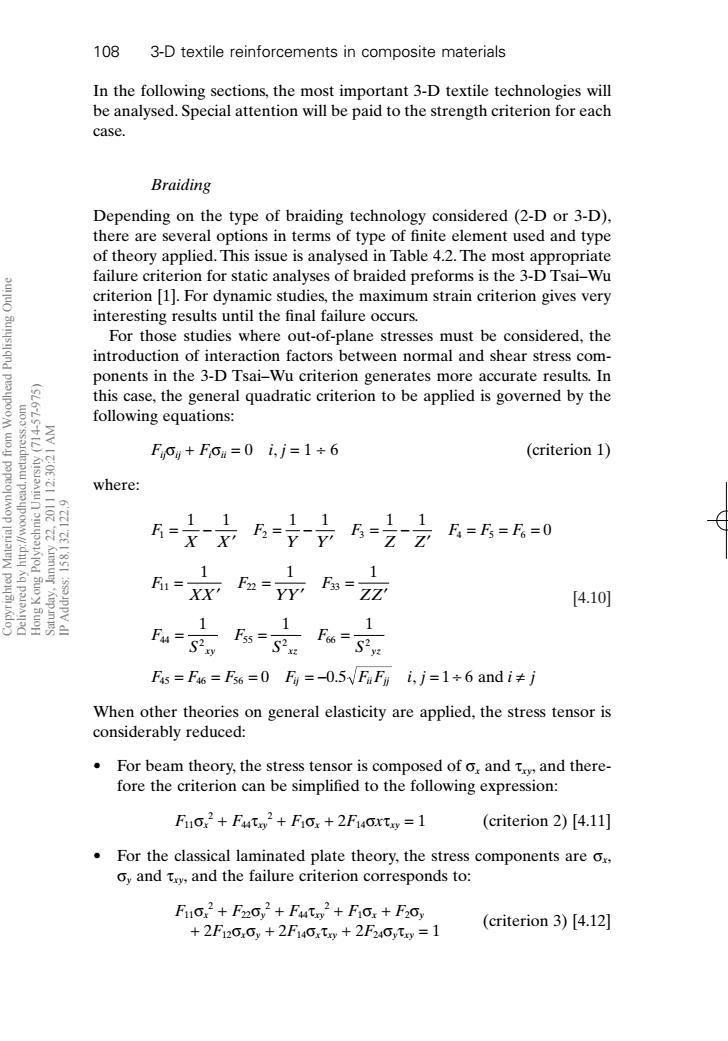正在加载图片...

108 3-D textile reinforcements in composite materials In the following sections,the most important 3-D textile technologies will be analysed.Special attention will be paid to the strength criterion for each case. Braiding Depending on the type of braiding technology considered(2-D or 3-D), there are several options in terms of type of finite element used and type of theory applied.This issue is analysed in Table 4.2.The most appropriate failure criterion for static analyses of braided preforms is the 3-D Tsai-Wu criterion [1].For dynamic studies,the maximum strain criterion gives very interesting results until the final failure occurs. For those studies where out-of-plane stresses must be considered,the introduction of interaction factors between normal and shear stress com- ponents in the 3-D Tsai-Wu criterion generates more accurate results.In this case,the general quadratic criterion to be applied is governed by the following equations: F0g+Foa=0i,j=1÷6 (criterion 1) where: :E=E=E=0 1 1 %m1 s、1 F8= ZZ [4.10] 1 1 F44=1 1 F5= F66= Fs=F6=Fs6=0F=0.5 VFaFn,ij=1÷6andi≠j When other theories on general elasticity are applied,the stress tensor is considerably reduced: For beam theory,the stress tensor is composed of o,and t,and there- fore the criterion can be simplified to the following expression: Fn02+Futo2+F1Gx+2FuGxtry=1 (criterion 2)[4.11] For the classical laminated plate theory,the stress components are ox, oy and tx,and the failure criterion corresponds to: FuGx+F2Cy2+Futo2+F10x F2Cy +2F120xOy +2F140xtoy 2F240ytry =1 (criterion 3)[4.12]108 3-D textile reinforcements in composite materials In the following sections, the most important 3-D textile technologies will be analysed. Special attention will be paid to the strength criterion for each case. Braiding Depending on the type of braiding technology considered (2-D or 3-D), there are several options in terms of type of finite element used and type of theory applied. This issue is analysed in Table 4.2. The most appropriate failure criterion for static analyses of braided preforms is the 3-D Tsai–Wu criterion [1]. For dynamic studies, the maximum strain criterion gives very interesting results until the final failure occurs. For those studies where out-of-plane stresses must be considered, the introduction of interaction factors between normal and shear stress components in the 3-D Tsai–Wu criterion generates more accurate results. In this case, the general quadratic criterion to be applied is governed by the following equations: Fijsij + Fisii = 0 i, j = 1 ∏ 6 (criterion 1) where: When other theories on general elasticity are applied, the stress tensor is considerably reduced: • For beam theory, the stress tensor is composed of sx and txy, and therefore the criterion can be simplified to the following expression: F11sx 2 + F44txy2 + F1sx + 2F14sxtxy = 1 (criterion 2) [4.11] • For the classical laminated plate theory, the stress components are sx, sy and txy, and the failure criterion corresponds to: F11sx 2 + F22sy 2 + F44txy2 + F1sx + F2sy + 2F12sxsy + 2F14sxtxy + 2F24sytxy = 1 (criterion 3) [4.12] F F F F FF i j i j 45 46 56 = = = =- = ∏ π 0 05 1 6 ij ii jj . , and F S F S F xy xz yz S 44 2 55 2 66 2 111 === F XX F YY F ZZ 11 22 33 1 11 = ¢ = ¢ = ¢ F X X F Y Y F Z Z 1 2 3 456 FFF 1 1 11 11 = - 0 ¢ = - ¢ = - ¢ === [4.10] RIC4 7/10/99 7:43 PM Page 108 Copyrighted Material downloaded from Woodhead Publishing Online Delivered by http://woodhead.metapress.com Hong Kong Polytechnic University (714-57-975) Saturday, January 22, 2011 12:30:21 AM IP Address: 158.132.122.9